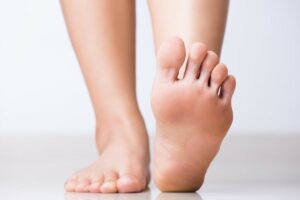Learn About the Causes of Pitted Keratolysis


Written and verified by the doctor Leonardo Biolatto
Pitted Keratolysis is typical in teenagers and young adult athletes. It’s a bacterial infection that usually affects the soles of your feet. However, it can also appear on the palms of your hands. Its name comes from the characteristic dimples or grooves it creates. In today’s article, we’ll tell you more about the causes of pitted keratolysis.
What is Pitted Keratolysis?
Pitted Keratolysis is a bacterial infection that affects the skin on your feet and palms.
The bacteria that cause this condition are usually gram-positive. That means that they turn purple when you use a specific stain on them under a microscope.
An article in FAPap in 1910 was the first to talk about Pitted Keratolysis. Castellini was the first specialist to identify the raised area of the skin as a variant of plantar hyperkeratosis. This condition causes the outermost layer of your skin to thicken.
This condition is very common. It’s especially prevalent in athletes, young adults, and during the summer. In addition, although it affects people all over the world, it’s most common in the tropics. That’s because humidity is one of the causes of Pitted Keratolysis.
In addition, it’s more likely to affect people who wear closed shoes for long periods of time. Also, it’s a common condition in certain professions.

Symptoms of Pitted Keratolysis
The name Pitted Keratolysis comes from the shape of the lesions it causes. The main symptoms are small holes in the outer layer of the skin on your palms or the soles of your feet.
Each dimple is usually 1/8 of an inch in size. However, they can be as large as 1/4 inch.
The dimples tend to clump together. They can clump together on your heels or the balls of your feet. Also, they’re more common in areas where you exert the most pressure while walking or standing.
Occasionally, those holes could turn into more serious injuries. When the infection begins, it’s common for the outer layer to thin and weaken. This helps the bacteria grow.
In addition, the grooves will become more prominent if you immerse the affected foot in water for a long period of time. Also, the skin in the affected area can change color and texture. The area tends to have a whitish and wrinkled appearance. However, it may also turn red if there’s inflammation, green if there’s an infection, or it can even turn black.
Another notable symptom is that the infection will start to smell. Many patients will say they have to deal with an unpleasant odor.
Keep reading: Six Natural Remedies for Athlete’s Foot Relief
Main causes of Pitted Keratolysis
Different species of bacteria can cause Pitted Keratolysis:
- Kytococcus sedentarius
- Dermatophilus congolensis
- Corynebacterium spp
- Actinomyces spp
All these species thrive in humid and dark environments. Soldiers, farmers, sailors, fishermen, and athletes are the groups that suffer from this condition most often.
In addition, the elderly, people with diabetes, and those with weakened immune systems are also at risk. And, although this condition can develop in people from all over the world, it’s more common in areas with warm and humid climates.
Pitted Keratolysis diagnosis
A general doctor or dermatologist can diagnose this condition. According to a publication by Dermnet NZ, they usually do it clinically. That means they don’t need to do any additional examinations.
There are some data doctors will collect to make the diagnosis, and they will also look for the characteristic lesions. In addition, they’ll ask about any pain or burning sensation you may experience while walking.
To differentiate this condition from others, the specialist may use other tests as well. For example, they may do a skin scraping to rule out the possibility of a yeast infection.
Also, they may use Wood’s light examination. This technique will look for a coral-red fluorescence when the doctor exposes it to a special light source.
Pitted Keratolysis treatment
Pitted Keratolysis is caused by bacteria. Therefore, your doctor will give you antibiotics to treat it. Normally, they’ll prescribe topical medications.
However, in some very specific situations, they may need to prescribe oral treatment. Some medications they may prescribe are erythromycin and clindamycin, as well as mupirocin, fusidic acid, and benzoyl peroxide.
The Spanish Society of Pediatric Emergencies states that the lesions usually disappear completely after two weeks. In addition, the smell should go away.
Home remedies
In addition to prescription medications, you can also try some home remedies to treat Pitted Keratolysis. They’re simple options, but you should talk to your doctor before using them. One thing you can do is apply an antiperspirant to your feet several times a week.
Additionally, you can wash your feet with soap or an antiseptic twice a day. Also, you should avoid wearing the same shoes for long periods of time. In fact, it’s best to change your footwear every day.

Also read: The Causes and Symptoms of Athletes Foot and How to Treat it at Home
Pitted Keratolysis prevention
You can prevent this condition. As you’ve read, humidity is one of the main factors and causes of Pitted Keratolysis. That’s why it’s important to keep your feet dry.
To help with this, you should wear close shoes or boots, and you should try to only wear them for a short period of time.
Also, we don’t recommend wearing the same shoes several days in a row or keeping them on for an entire day. In addition, you should avoid sharing shoes or towels with other people.
Conclusion
Pitted Keratolysis is a bacterial infection that mostly affects people’s feet, but it can also affect your hands. It’s more common in people who spend a lot of time in closed-toe shoes, who live in hot climates, and who play sports regularly.
This condition can cause a bad odor and lesions that look like dimples on the surface of your foot. It’s easy to identify, but it’s always necessary to talk to a doctor so they can prescribe the best treatment for you.
All cited sources were thoroughly reviewed by our team to ensure their quality, reliability, currency, and validity. The bibliography of this article was considered reliable and of academic or scientific accuracy.
- Queratolisis Punctata. (n.d.). Retrieved May 19, 2021, from https://seup.org/pdf_public/reuniones/2019/Posters/P_195.pdf
- Pitted keratolysis | DermNet NZ. (n.d.). Retrieved May 19, 2021, from https://dermnetnz.org/topics/pitted-keratolysis/
- FAPap – Queratolisis-punctata-conocer-es-diagnosticar. (n.d.). Retrieved May 19, 2021, from https://fapap.es/articulo/269/queratolisis-punctata-conocer-es-diagnosticar
This text is provided for informational purposes only and does not replace consultation with a professional. If in doubt, consult your specialist.








